Eat That Frog is a productivity method developed by Brian Tracy and described in his book Eat That Frog!: 21 Great Ways to Stop Procrastinating and Get More Done in Less Time. Both the book and the method get their names from a quote usually attributed to Mark Twain (though whether Twain actually said/wrote it has been debated): "Eat a live frog first thing in the morning and nothing worse will happen to you the rest of the day."
Applied to work, Tracy says that your "frog" is the most important and most impactful task you have to complete. If you eat the frog (i.e., work on it) first thing every morning, you'll be more productive and successful, and you'll reach your goals more quickly.
And while Eat That Frog is best-known for its namesake advice, the book itself contains 21 different principles people can follow to boost their productivity. It's a digest of productivity techniques—bringing together practices like time-blocking, the Pareto principle, and prioritizing tasks—that, when combined, all work to support the core Eat That Frog productivity method.
Tracy presents some actionable advice for each principle in his book, but he typically recommends a single approach to executing on each principle. Of course, productivity is highly personal: What works for one person may not work for someone else. So in addition to presenting Tracy's ideas and recommendations below, we've linked to several Zapier resources that include additional information and alternative approaches so you can get to know the science behind certain principles and easily find an approach that feels right for you.
The 21 Principles of the Eat That Frog Productivity Method
While the core methodology of Eat That Frog sounds simple, it actually requires you to conduct a series of activities and develop several habits before you can succeed with the approach
In his book, Tracy describes each of those activities and habits as the 21 core principles of the Eat That Frog method. Some of the principles are things you need to do before you start using the method. Others are things you need to keep in mind as you practice the method to ensure you're always prioritizing your frogs. So it's best to familiarize yourself with all of the principles before you get started.
Below are summaries of each of Tracy's 21 principles, along with links to Zapier resources that will help you learn more about the research supporting each principle, find alternatives to the specific methods and activities Tracy recommends, and discover some tools that may help you streamline your new approach to managing your tasks and schedule.
1. Define your goals and write them down
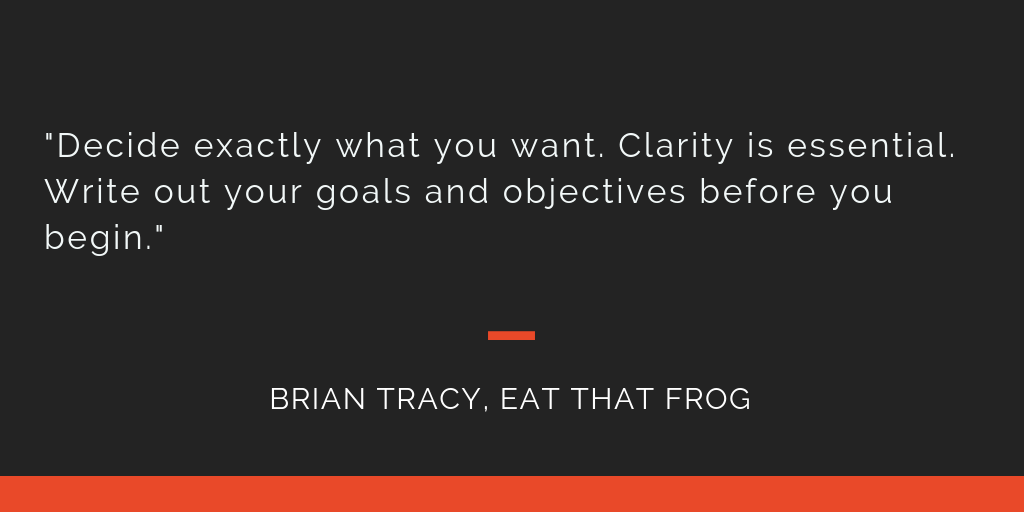
Tracy says that lack of clarity is one of the biggest causes of waste and procrastination. If you don't know exactly what your goals are—what you're striving to achieve—it's unlikely that you'll be able to identify and prioritize the specific tasks you need to work on to achieve those goals.
Consider what you want to achieve personally, or work with your boss to define your major work goals. Then, write your goals down so that you can refer back to them frequently. "A goal or objective that is not in writing is merely a wish or fantasy," Tracy says. "Unwritten goals lead to confusion, vagueness, misdirection, and numerous mistakes."
Once you've documented your goals, set a deadline for when you want to achieve them, break them down into every task that needs to be done in order for you to achieve those goals, and resolve to work on one goal task every single day.
Your goal tasks are your frogs—the things you want to work on first thing every day for greater productivity and success.
Resources to help you define your goals:
When defining your goals, it helps to use SMART criteria. Here's how to reach any goal with a spreadsheet, calendar, and the SMART system.
If you're having trouble brainstorming the tasks you need to complete to reach your goals, consider using a brainstorming technique like mind mapping to jumpstart your thought process.
2. Create plans for what you'll work on
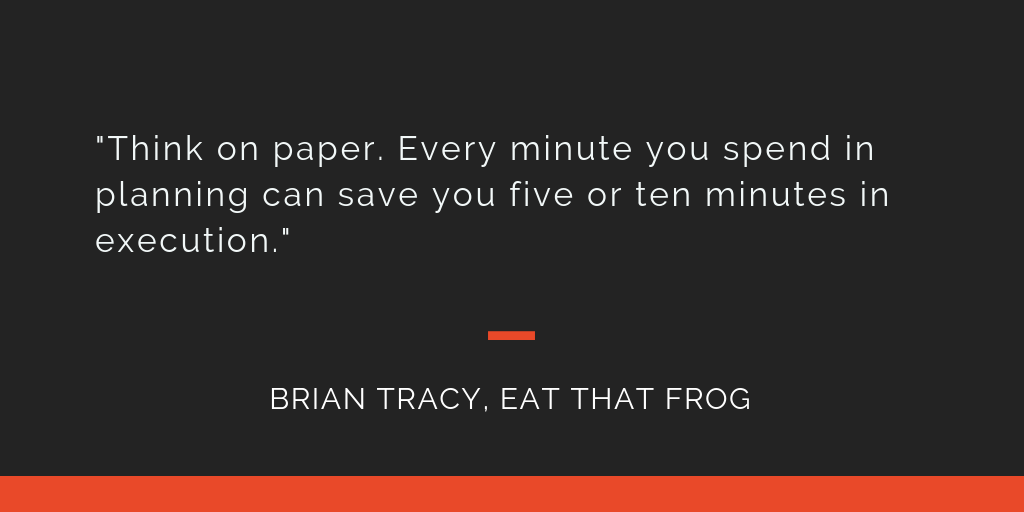
Tracy says that the first step in proper planning is having a list of tasks you need to complete. He recommends keeping multiple lists:
a master list of all of your tasks
a monthly list of tasks you want to complete that month
a weekly list of tasks you want to complete that week
a daily list of tasks you want to complete that day
Each subsequent list pulls from your master list. You plan your monthly list at the end of each month, your weekly list at the end of each week, and your daily list at the end of each day. By planning your tasks for the next day at the end of the previous workday, you'll know exactly what your frog is when you arrive at work in the morning and can get started on it immediately.
Resources to help you create multiple to-do lists:
While you can document your lists on paper, a to-do list app makes managing multiple lists easier by letting you drag-and-drop tasks between lists.
If you're not a fan of to-do list apps, here's how to find something that works for you.
If you're more of a visual thinker, consider these creative ways to visualize your to-do list.
3. Focus on your 20% tasks
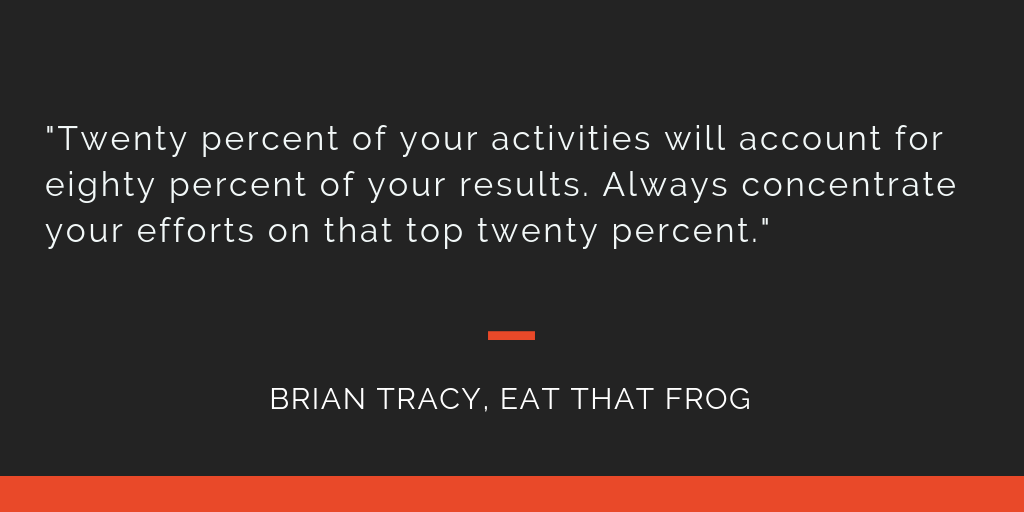
The Pareto principle states that you tend to get 80% of your results from 20% of your work. Tracy says that focusing on your frogs ensures that you're always prioritizing the 20% tasks that are the most important.
That's a big reason why you need to define your goals, break them down into tasks, and work on one goal task every day. When you don't, you end up spending all of your time on 80% tasks—small, low-value tasks that fail to get you closer to meeting your goals.
A big part of making sure you're always working on 20% tasks is prioritization. Your master list of tasks will be ever-changing, so take time to prioritize to make sure you know which tasks will provide the most value.
Resources to help you focus on your 20% tasks:
There are a lot of different prioritization techniques you can use to make sure your 20% tasks are always at the top of your to-do list. Here are six different ways to ruthlessly prioritize your task list.
If none of those methods work well for you, you may want to try Agile prioritization.
4. Think long-term to make better short-term decisions
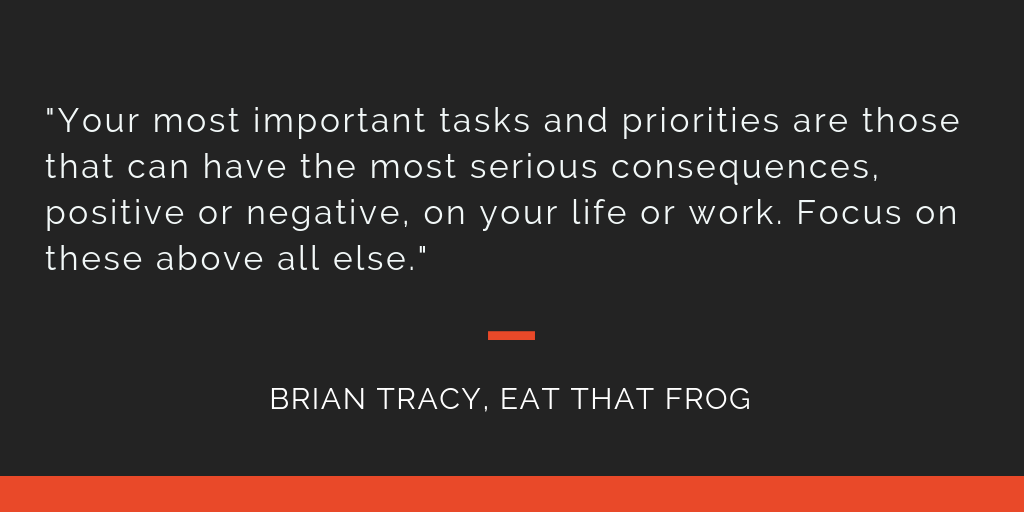
Another prioritization method that Tracy recommends is to ask: "What are the potential consequences of doing or not doing this task?"
It's easy to think that you need to complete everything on your to-do list. But the reality is that some things simply don't need to be done. Other things are better delegated to others.
If you question the consequences of doing/not doing a to-do before you start on it, it not only makes it easier to find your frogs, but it also makes it easier to find time-wasting tasks that are better deleted from your list or delegated to someone else.
Resources to help you trim down your task list:
If you're struggling with this exercise, you might want to consider the "do it, delegate it, defer it" decision-making process recommended in GTD®.
Another approach is Zen to Done's process habit where you mark tasks as do, defer, delegate, delete, or file.
5. Procrastinate on purpose
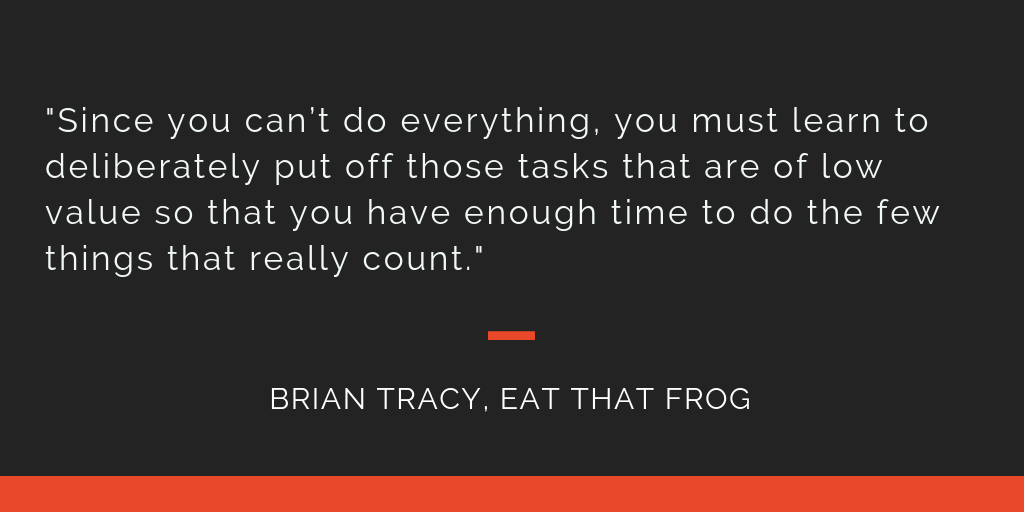
"Everyone procrastinates," Tracy writes. "The difference between high performers and low performers is largely determined by what they choose to procrastinate on."
Procrastination is usually considered a bad thing, but the reason it has a negative connotation is that we typically procrastinate on our frogs. Our frogs are often big, difficult tasks, so they're easy to put off. Low-value tasks, on the other hand, can often be completed quickly, so they're easier to knock out and mark off of our lists.
Instead of procrastinating when it comes to your frogs, Tracy recommends procrastinating intentionally on your 80% tasks.
For example, an old boss of mine once mentioned that he ignored emails from people asking questions they could easily get the answers to themselves. He would only reply if those people sent a follow-up email. But most of the time, when he didn't reply, people would find the answer themselves, eliminating one thing from his to-do list.
Resources to help you procrastinate intentionally:
Want to learn more about productive procrastination? Here's how to get things done by putting off other things.
If you're having trouble finding the motivation to get started on your frogs, consider these tips on what to do when you can't get things done and how to start doing a thing when you really, really don't want to.
6. Use the ABCDE method
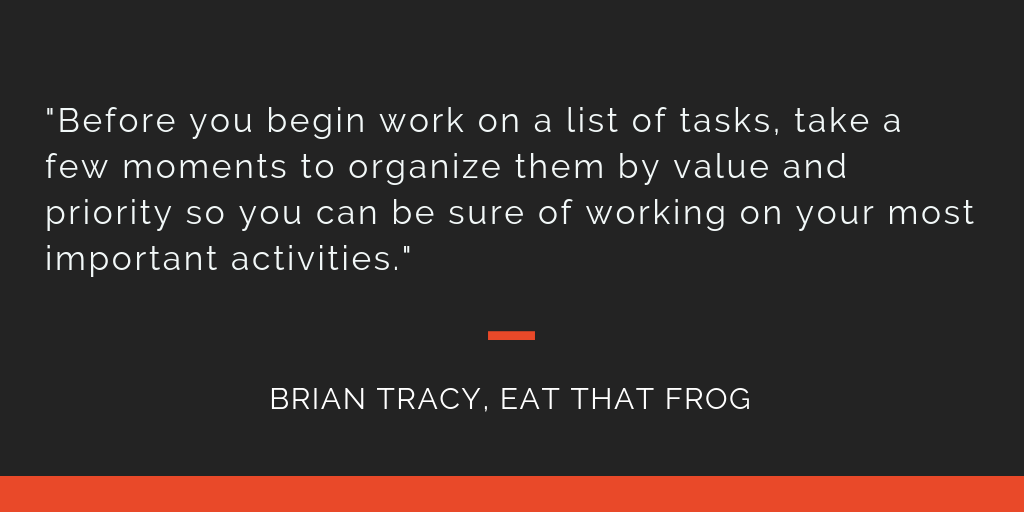
Another prioritization method Tracy recommends is the ABCDE method:
"A" tasks are things you must do; they're your frogs. If you have more than one must-do task, you can prioritize further by adding numbers: A-1, A-2, A-3, etc.
"B" tasks are things you should do. Replying to emails or attending meetings are often should-do tasks. People may be upset if you don't, but these activities aren't necessarily getting you closer to your goals, so they're a lower priority than "A" tasks.
"C" tasks are nice-to-dos. You probably want to do them, but there are no consequences if you don't.
"D" tasks are things you should delegate to someone else so you have more time for your "A" tasks.
"E" tasks are things you should eliminate. You don't need or want to do them, and there's no value in delegating them to someone else.
Tracy says you should evaluate your task list using this method frequently. As time passes, priorities often change, and you want to make sure that your prioritization reflects those changes.
Resources to help you prioritize your task list:
If the ABCDE approach method doesn't work for you, you may want to consider creating an Eisenhower Matrix instead.
Agile prioritization is another alternative that uses the categories "critical," "high," medium," and "low" to categorize the priorities of tasks.
7. Understand exactly what work you're accountable for

Work is one of the hardest places to focus on your frogs because there are a million ways to get pulled into other activities. There are emails and IMs to answer, meetings to attend, side projects to pick up, and—if you work in an office—plenty of in-person distractions.
To prevent these things from derailing you, you need to understand what Tracy calls your "key result areas." What were you hired to do? What results are you supposed to deliver? By understanding what you're truly accountable for, you can justify delegating and deleting tasks that aren't related to your job-specific tasks and goals.
Resources to help you hand off work you don't need to do:
If you're struggling to hand off tasks that aren't related to your core responsibilities, you might consider learning more about the art of delegating.
If you don't have people you can delegate to, consider hiring a virtual assistant or using a tool like Zapier to automate some of your work tasks.
8. When it's time to work, work
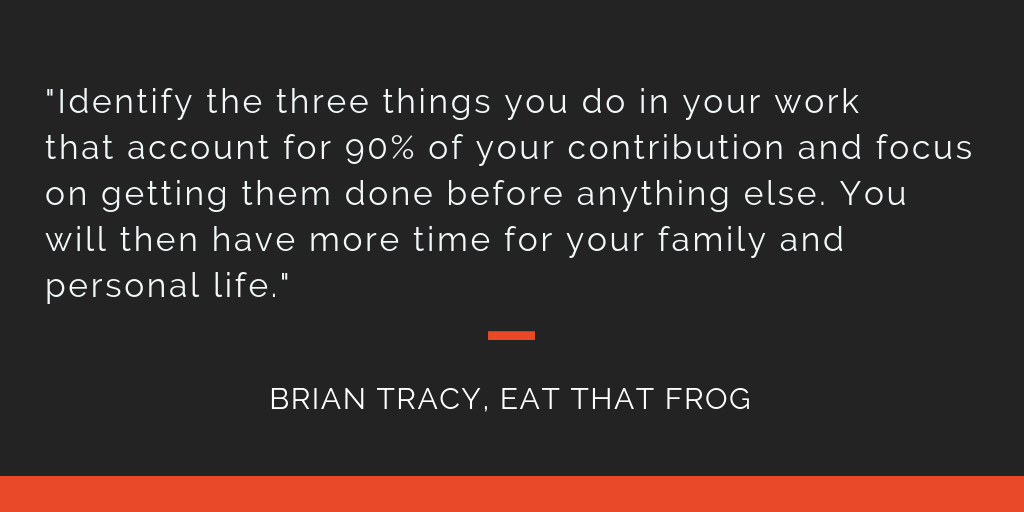
Tracy says that the best way to achieve work-life balance is to work the whole time you're at work.
Every minute you spend at work on productivity-killing activities like chatting with coworkers about your favorite TV shows or scrolling through social media negatively impacts your time away from work—either because you have to work overtime or because you're stressing over unfinished tasks.
Resources to help you stay focused:
If you're struggling to focus on your work while you're at work, consider using one of these apps that help you focus and block distractions.
You can also tweak your software settings to minimize distracting notifications.
9. Prepare for your work before you start on it
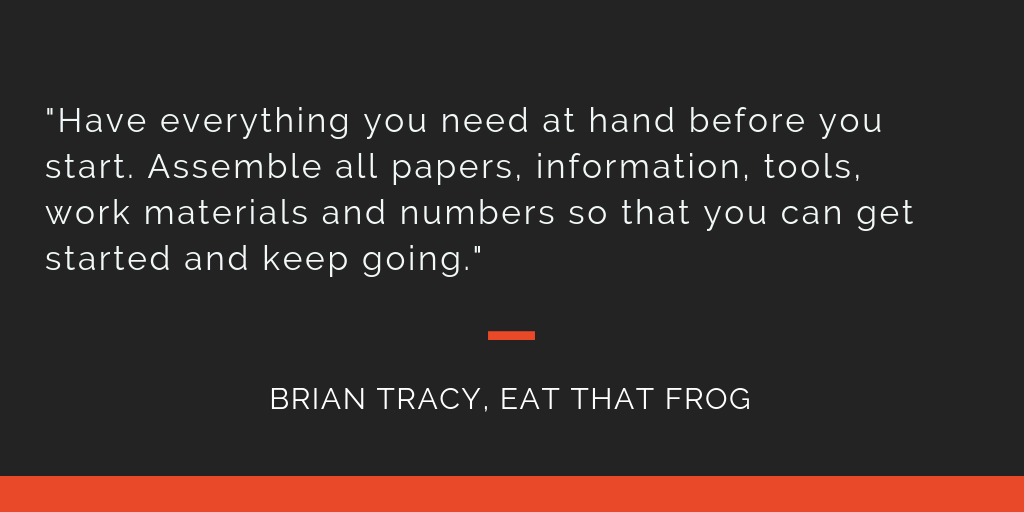
Part of preparing for your work in advance is planning your frog for the next day at the end of the previous workday and blocking off time to work on that frog so you can tackle it interruption-free. But another part is making sure you have all of the things you need to do your work and a comfortable workspace to do it in.
Learn how your workspace affects your productivity:
Science has shown that there's a direct connection between productivity and ergonomics, so make sure your workspace is set up for optimal productivity.
Noise can also impact your productivity, so while it's good to occasionally change where you work, it's also good to try to find a quiet space where you can stay focused.
10. Focus on one task at a time
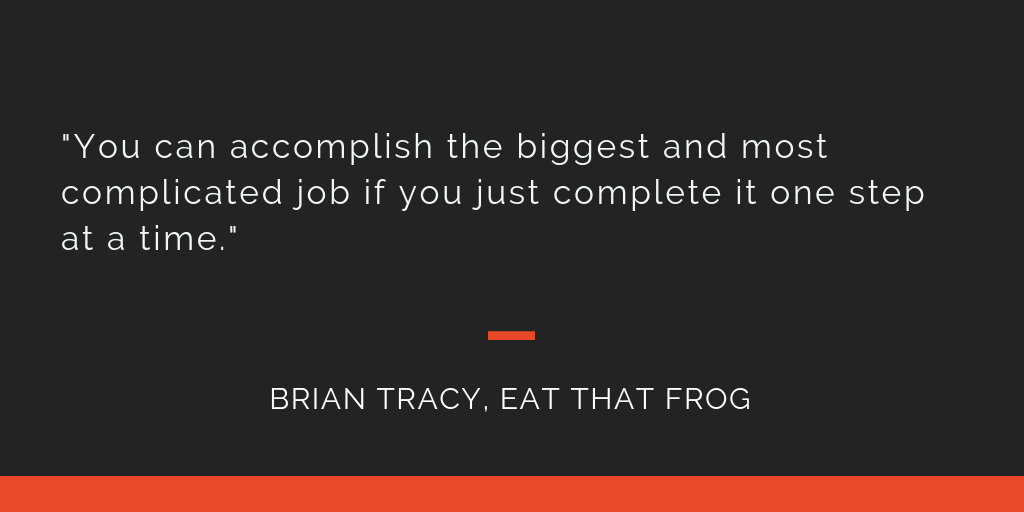
When you planned your goals, you also broke those goals down into multiple tasks. That's an important part of reaching your goals because the larger and more overwhelming a task feels, the more likely you'll be to procrastinate doing it.
But once you have your goals broken down into tasks, you have to work on those tasks one at a time. Prioritize them, schedule them, and then when it's time to eat your frogs, focus on them completely.
Resources to help you monotask more efficiently:
Multitasking makes it more likely that you'll struggle to complete your key tasks, but perhaps more importantly, it's also bad for your mental health.
Practicing mindfulness is another way to train yourself to stay focused and fully immerse yourself in the tasks you're working on.
11. Develop your skills
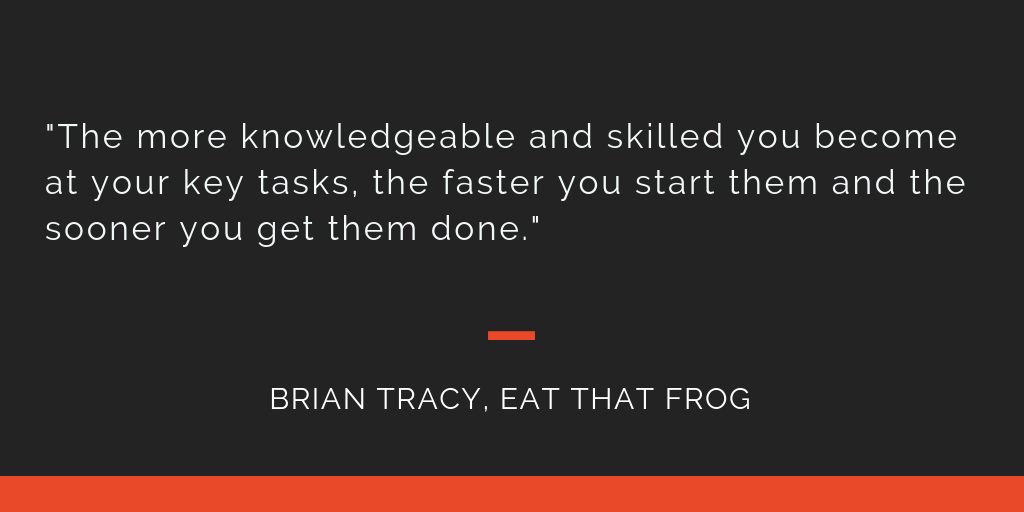
"A major reason for delay and procrastination is a feeling of inadequacy—lack of confidence or ability in a key area of the task," Tracy says. If you're suffering from imposter syndrome or feel unequipped to tackle the tasks you need to complete to meet your goals, you'll lean into procrastination.
Resources to help you develop your skills:
Consider using these strategies for learning new skills.
Learn how to find a mentor.
Follow these tips to make the most of your next business conference.
12. Use your strengths
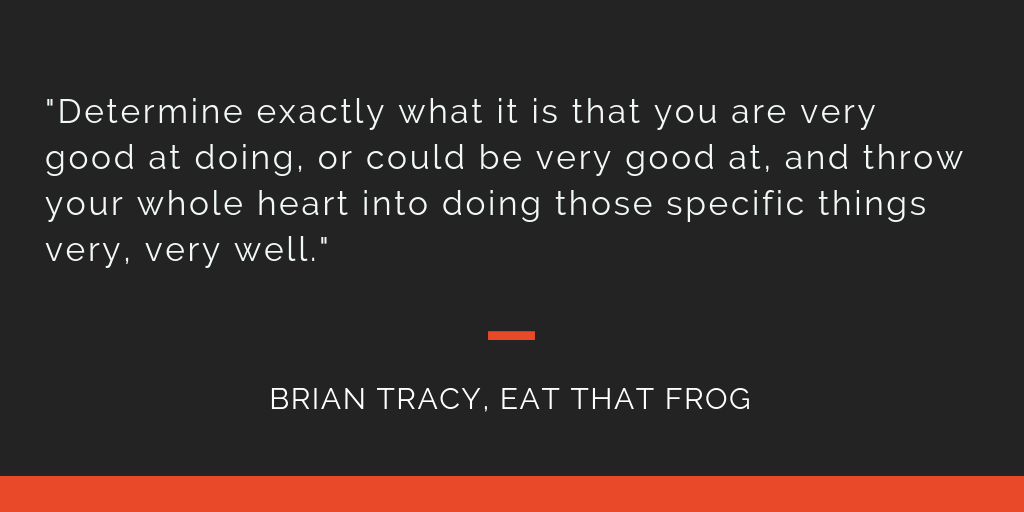
Tracy says that we each have unique skills we can employ that let us "eat specific frogs faster and better than others."
To meet your goals more quickly, identify your strengths and center your goals around those strengths. According to Tracy, doing what you're good at—and what you love to do—can significantly increase your "earning ability."
Resources to help you find and use your strengths:
Learn more about why it's helpful to focus on your strengths, plus some exercises to help you identify what you excel at.
If you aren't able to use your strengths in your current job and are ready to look for a new one, discover some modern job search strategies, learn how to growth hack your job search, or find the perfect job using Google search operators.
13. Identify the things that are holding you back
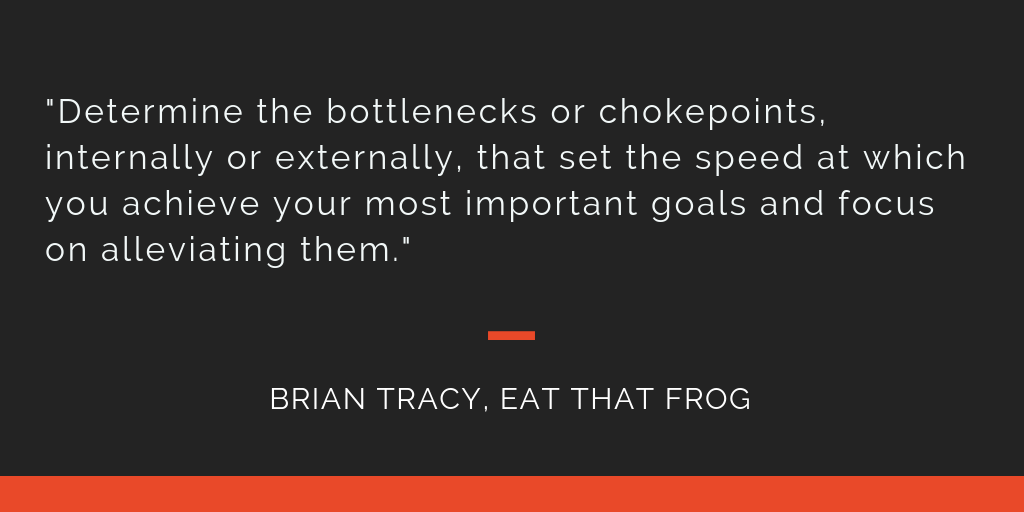
Once you've defined your goals, ask yourself: "Why haven't I achieved this goal yet?"
Sometimes, the answer to that question will be an external factor. You can't meet your goal of writing five blog posts a week because your calendar looks like a game of checkers. Your first priority, then, is to eliminate that constraint so you can devote more time to your frogs.
But Tracy says that more often than not our constraints are internal. We procrastinate because of imposter syndrome, or we fill our time with low-value tasks and distractions. If you can identify those constraints and eliminate them, you'll progress toward your goals much more quickly.
Resources to help you remove roadblocks:
If your bottlenecks are related to collaboration, consider these tips for how to fix common collaboration problems.
Learn how cognitive bias may be impacting your decision-making process—and how to overcome fallacious thought patterns.
14. Find your motivation
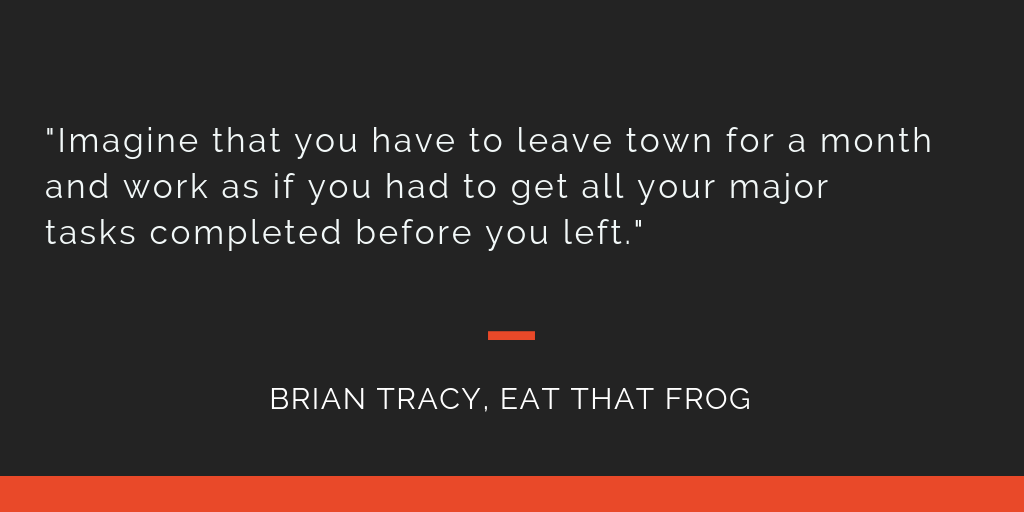
It's easy to get started on and complete a task that your boss has assigned to you with a deadline. It's harder to get started on and complete a task just because you want to—even if you know the outcome of completing the task will be positive.
Tracy says that you need to find ways to motivate yourself to eat your frogs by putting the same pressure on yourself that you feel when you're assigned a task and deadline by your boss. Create your own deadlines, try to beat the deadlines you've set, and hold yourself to high expectations.
Resources to help you get motivated:
For more actionable tips, consider these science-backed ways to motivate yourself.
Learn how to stop missing deadlines, or approach deadlines with the right mindset so they're less stressful and more motivational.
15. Make the most of your energy levels
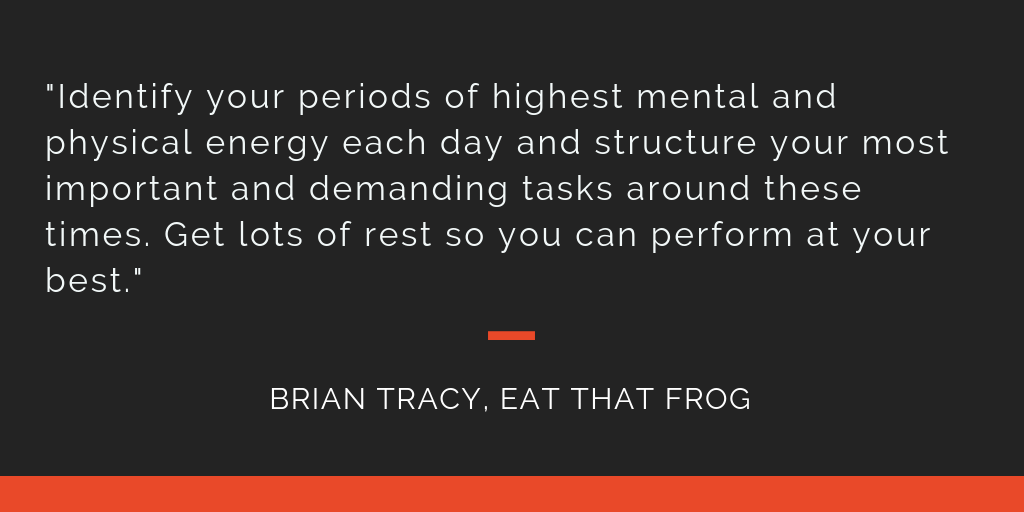
Tracy says that another way to be your most productive is to "guard and nurture your energy levels." Working too-long hours, failing to get enough sleep, eating unhealthy foods, and forgoing exercise are all ways we deplete our energy reserves, and as a result, our productivity suffers.
We all have an internal clock—or chronotype—that impacts our energy levels throughout the day. If you work with your chronotype, you're more productive. If you work against it, you're less productive. If you take time to find your chronotype, you can use it to your advantage to eat your frog at the point in the day when you're most likely to be energized and focused.
Learn more about how self-care impacts productivity:
Scientific research tells us that there's a connection between sleep and productivity and gives us ways to take better and more refreshing breaks.
It also helps to create a daily routine you can follow to make sure you're doing everything you need to do to be your most productive and successful.
16. Become an optimist
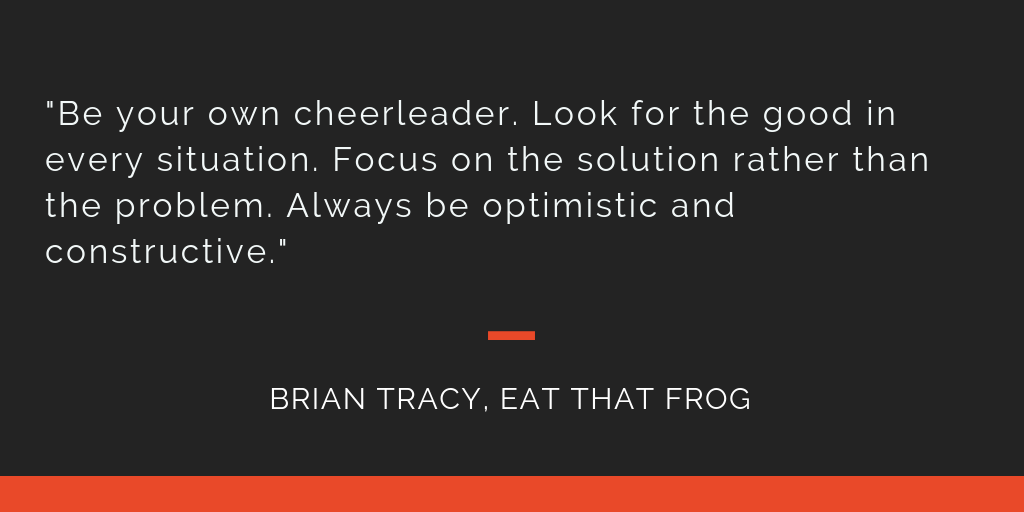
Another way to motivate yourself to eat your frogs and meet your goals is to control your thoughts. Instead of letting negativity slip in and derail your plans, Tracy says you must "refuse to let the unavoidable difficulties and setbacks of daily life affect your mood and emotions."
If your personality trends more toward pessimist than optimism, you may be rolling your eyes at this principle. In that case, it helps to think of it less as "being a cheerleader" and "seeing the good in every situation" and more as overcoming the negative thoughts and skepticisms that prevent you from moving forward.
You don't necessarily have to be an optimist; you just have to learn how to dismiss the thoughts that tell you it's not worth continuing to work toward a goal after you run into delays, problems, or disappointments.
Learn more about how your mood impacts productivity:
Your mood in the morning can have a direct impact on your productivity for the rest of the day.
Multitasking can also negatively impact your mood, causing you to feel unproductive even when you weren't.
17. Don't let technology distract you
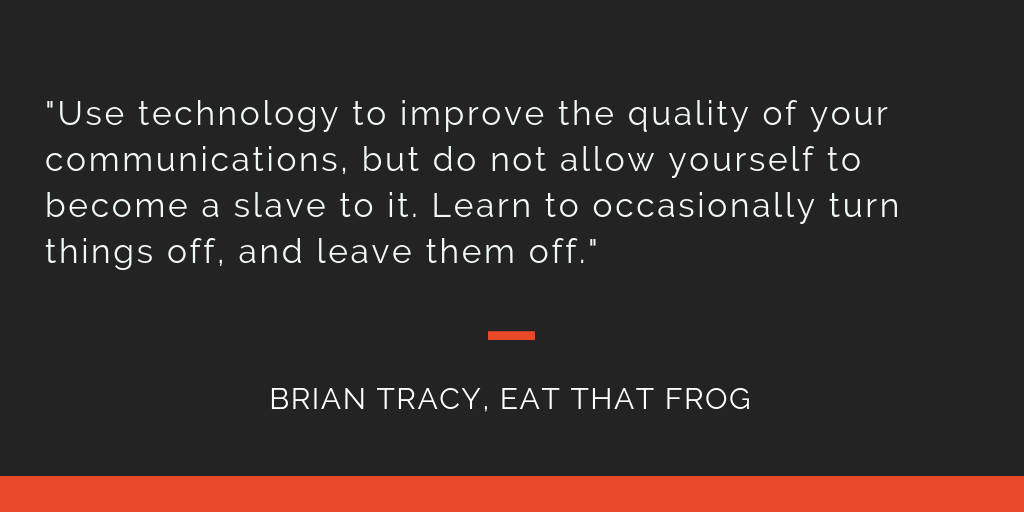
Technology is designed to make you more productive, but if you use it incorrectly, it has the opposite effect. If it feels like you spend your days hopscotching through emails, instant messages, and phone notifications instead of accomplishing important tasks, it's time to reset and rethink how you're using technology.
Resources to help you avoid technology distractions:
Consider these bad work habits you may have adopted to find ideas for breaking those habits.
If you're not sure if your technology habits are getting in the way of your work, consider using a time-tracking app to see how long you're spending on things like email, chat, and social media.
18. Break your tasks down to their smallest possible components
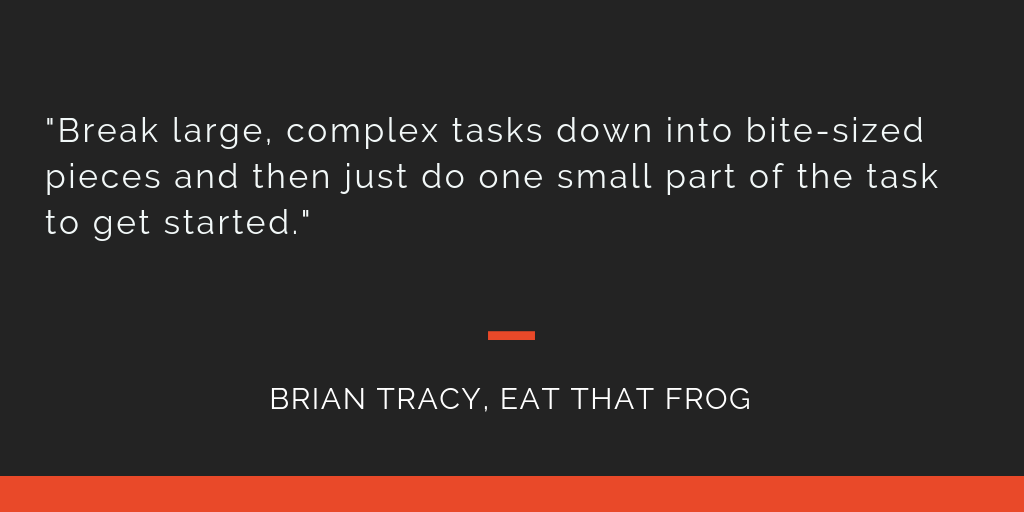
After you defined your goals, you broke those goals down into actionable tasks. But Tracy recommends taking it a step further and breaking your tasks down into the smallest possible components. The smaller the task, the easier it will be to start and complete because you'll be less overwhelmed by the idea of jumping into the task.
As an example, let's say your goal is to make $20,000 more this year. To do that, you'll have to find a new job. One task you need to complete is updating your LinkedIn profile, but it needs a lot of work. Instead of having the task "update LinkedIn profile" on your to-do list, break that down into smaller tasks.
Then, your to-do list will be filled with smaller, more manageable tasks like "write a summary for my LinkedIn profile," "ask coworkers for recommendations," and "document my responsibilities and accomplishments for my current role."
Resources to help you break tasks into subtasks:
The Agile prioritization technique includes a process for breaking tasks down into their smallest components.
You may also want to consider adopting an MVP mindset to take an iterative approach to meeting your goals that lets you achieve valuable milestones at multiple steps along the way.
19. Schedule time on your calendar for eating your frogs

To make progress on your frogs, you need large blocks of time to focus on them. But finding large blocks of time to focus on tasks requires a dedicated effort. You can't leave it to chance and hope no one schedules a meeting in a time slot you'd hoped to dedicate to working on your goal tasks.
Instead, Tracy recommends scheduling time for focused work. Schedule time on your calendar at the end of every workday for working on your frog the next morning, or create a recurring meeting for the first two hours (or whatever amount of time is appropriate) of every day to make sure you always have time blocked for goal tasks.
Resources to help you schedule time for your tasks:
Learn more about the time blocking technique and discover some great apps you can use to block time for your frogs easily.
If none of the apps in the article above work for here, here are a few free time blocking apps to consider.
20. Find your flow
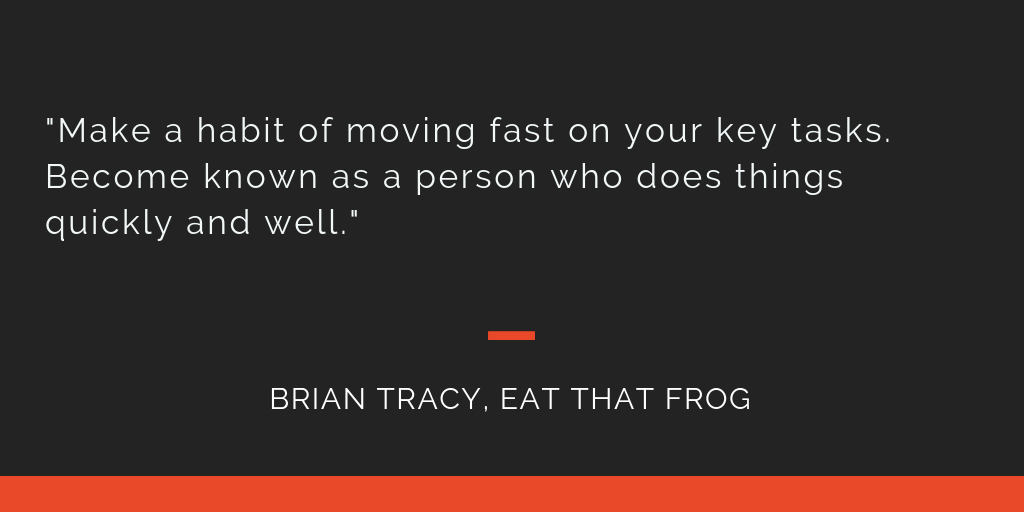
Flow is an optimal productivity state where you're fully immersed in and focused on the task at hand—so much so that you barely notice the passing of time. While in flow, Tracy says you "feel elated and clear. Everything you do seems effortless and accurate. You feel happy and energized."
And while flow can feel like something that just happens, there are ways to trigger your flow state. Tracy says that creating a sense of urgency helps, as does building up momentum.
The more tasks you complete that move you closer to your goal, the more momentum you'll build. Often, the simple act of continuing to make progress toward your goals makes it easier to trigger your flow state when working on goal tasks.
Resources to help you get into flow state:
Follow these five steps to trigger your flow state.
Consider using the Flowtime Technique to ensure you're able to get into flow state but also taking breaks when you need them.
21. Work on a task until it's complete
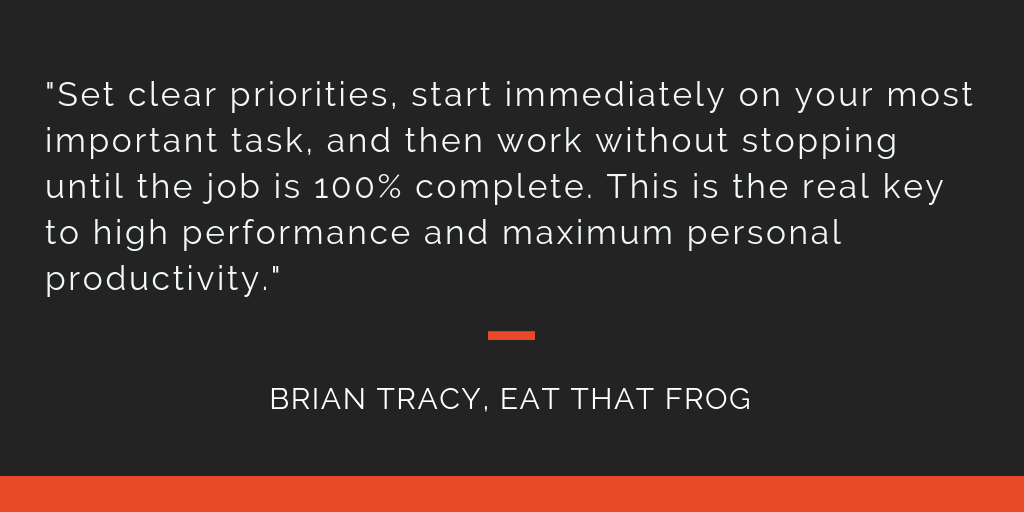
After you start working on a frog, continue working on it until it's complete. When you stop working on a task to focus on something else, it increases the amount of time it will take you to complete your original task. So once you've selected a task and have started working on it, work on it until you can take it off of your to-do list.
To do this effectively, you'll need to make sure you have tasks that are small enough to complete in one sitting. You'll need to make sure you have time blocked to work on your task. And finally, you'll need to make sure you've correctly estimated the time it will take you to complete the task.
Resources to help you finish your frog in one sitting:
If you're struggling to accurately estimate how long tasks will take you to complete, try these exercises for forming more realistic estimations.
If you find yourself struggling to get started on your task, it might help to learn more about the four main motivators for productivity and the science behind them.
A Summary of the Eat That Frog Productivity Method
These 21 principles make the Eat That Frog productivity method sound like a lot of work, but in truth, the approach is pretty simple:
Define your goals and write them down.
Break those goals down into tasks.
Break those tasks down into the smallest possible subtasks.
Prioritize your tasks, and delete/delegate tasks you don't need to do.
Schedule time on your calendar every single day, ideally first thing in the morning, to work on your highest-priority goal task.
Focus on your goal task during your scheduled time, and work on it until it's complete.
Your goal tasks and their subtasks are each your frogs—the things you want to "eat" first thing every day to ensure you stay focused on completing your most impactful work.
That's really the essence of Eat That Frog—all of the other principles are designed to support your efforts and avoid things like negative thinking, technology interruptions, poor planning, and lack of clarity that get in your way of following those six steps.
"Make a decision to practice these principles every day until they become second nature to you," Tracy says. "With these habits of personal management as a permanent part of your personality, your future success will be unlimited."















 />
/>








































